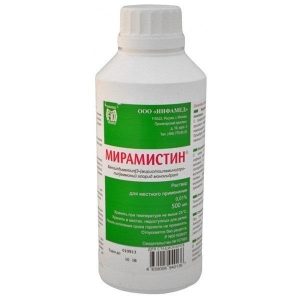Description
Release form
eye drops
Packing
Bottle 25 ml
Pharmacological action
Levomycetin is an antimicrobial agent effective against a wide range of gram-positive and gram-negative microorganisms. It has a pronounced bacteriostatic effect, in high concentrations in relation to some strains it shows a bactericidal effect.
The mechanism of action is based on the ability to bind to the 50S subunit of bacterial ribosomes and inhibit protein synthesis in bacterial cells. Strains of Escherichia coli, Shigella spp. Are sensitive to the action of chloramphenicol. (including Shigella dysenteria), Salmonella spp., Streptococcus spp. (including Streptococcus pneumoniae), Neisseria spp., Proteus spp., Ricketsia spp., Treponema spp. and Chlamydia trachomatis. In addition, the drug is effective in diseases caused by certain strains of Pseudomonas aeruginosa. The effect of the drug does not apply to fungi, protozoa and strains of Mycobacterium tuberculosis.
The resistance of microorganisms to chloramphenicol develops slowly. After oral administration, the drug is rapidly absorbed in the gastrointestinal tract. Oral bioavailability reaches 80%. Peak plasma concentrations are observed 1-3 hours after administration. After oral administration, therapeutically significant concentrations remain in the blood plasma for 4-6 hours, after parenteral administration for 8-12 hours.
The degree of binding of chlorpheniramine to plasma proteins is about 50%. Chloramphenicol crosses the blood-brain and blood-brain barrier, excreted in breast milk. It is metabolized in the liver, excreted mainly by the kidneys, some of the drug is excreted by the intestines. The half-life reaches 1.5-3.5 hours.
In patients with impaired renal function, the elimination half-life increases to 3-4 hours, in patients with impaired liver function – up to 11 hours.
Indications
Bacterial infections of the eye, including conjunctivitis, keratitis, keratoconjunctivitis, blepharitis, episiscleritis, scleritis
Contraindications
Hypersensitivity, hematopoietic diseases, acute intermittent porphyria, severe renal and hepatic impairment, glucose-6-phosphate dehydrogenase deficiency, psoriasis, eczema, fungal skin diseases, neonatal period (up to 4 weeks) and early childhood.
Use during pregnancy and lactation
During pregnancy, it is possible if the expected effect of therapy exceeds the potential risk to the fetus (there are no adequate and strictly controlled studies on the use during pregnancy, the ability of chloramphenicol to cross the placenta should be considered).
Special instructions
Due to its high toxicity it is not recommended to use it without treatment for the prophylaxis and prophylaxis of common infections, colds, flu, pharyngitis, bacteriocarrier.
Severe complications of the hematopoietic system, as a rule, are associated with the use of large doses (more than 4 g / day) for a long time. In the process of treatment, systematic monitoring of the peripheral blood picture is necessary.
In the fetus and newborns, the liver is not sufficiently developed to bind chloramphenicol, and the drug can accumulate in toxic concentrations and lead to the development of gray syndrome, therefore, in the first months of life, the drug is prescribed only for health reasons.
Use with caution in patients who have previously received treatment with cytotoxic drugs or radiation therapy.
Composition
Active ingredient: chloramphenicol
Dosage and Administration
Locally, 0. 25% aqueous solution – 1-2 drops per conjunctival sac every 1-4 hours (conjunctival sac usually holds only 1 cap) 1% ophthalmic liniment (about 1 cm) – put over the eyelid every 3 hours.
Side effects of
From the digestive tract: dyspepsia, nausea, vomiting, diarrhea, irritation of the mucous membrane of the mouth and throat, dysbiosis.
From the cardiovascular system and blood (hematopoiesis, hemostasis): leukopenia, thrombocytopenia, reticulocytopenia, hypogemoglobinemia, agranulocytosis, aplastic anemia.
From the nervous system and sensory organs: psychomotor disorders, depression, impaired consciousness, delirium, optic neuritis, visual and auditory hallucinations, taste disturbance, decreased hearing and visual acuity, headache.
Allergic reactions: skin rash, urticaria, angioedema.
Other: dermatitis, secondary fungal infection, cardiovascular collapse (in children under 1 year).
For skin application and conjunctival use: local allergic reactions.
Storage conditions
In the dark place at a temperature of no higher than 25 ° C.
Term hodnosty
2 years
Active ingredient
Chloramphenicol
Pharmacy leave conditions
OTC
Form of Treatment
simply entails dlya naruzhnogo primeneniya
Appointment
Children prescribing seniors28 doctor, Adult
Indications
Burns, From bedsores, From trophic ulcers, From skin infections, From boils
Possible product names
Levomycetin vials 3%, 25 ml



